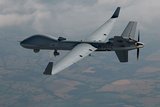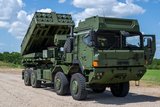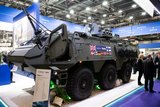Pearson integrates AI-driven explosive detector with UAV
Threat-Sense has been designed to detect ground-laid ordnance and explosive threats. (Photo: Pearson Engineering)
Pearson Engineering has developed a vehicle-integrated UAV system to detect ground-laid ordnance such as improvised explosive devices (IEDs), anti-tank and anti-personnel mines.
The Threat-Sense system supports the identification of threats to mobility, including vehicles and dismounted soldiers, with the use of UAVs combined with artificial intelligence (AI) and synthetic threat libraries.
Threat-Sense was designed to provide increased situational awareness to vehicle commanders and has been field tested when integrated with platforms ranging from Foxhound and HX60, to the Patria AMV and TRX 2 robotic combat vehicle.
Related Articles
Pearson launches detect and displace capability for scatterable mines
Pearson Engineering delivers countermine technology trials to the British Army
Adaptability – A Battlefield Advantage (sponsored)
The platform was developed by Pearson Engineering’s unmanned solutions team for integration with a UAV to assist enhanced reconnaissance and stand-off from the vehicle after feedback from users and international science and technology organisations.
The system was evaluated and proven with NATO allies at the Suffield Research Centre in Canada to demonstrate freedom of manoeuvre and mobility at pace using a commercially available off-the-shelf UAV to a distance of 5km to reduce the risk to life and providing an additional method of surface laid threat identification.
Threat-Sense logs all of the detected threats with unique identifiers, GPS markers and timestamps, and has the ability to network information over Android team awareness kit or data distribution service in real time.
Threat-Pathway, a newer development designed to provide rapidly deployable scatterable mine clearance capability to combat vehicles and combat support vehicles, has also taken part in a number of end-user demonstrations and trials.
More from Land Warfare
-
![Croatia orders Leopards and CAESAR howitzers as Lithuania orders more CAESARs]()
Croatia orders Leopards and CAESAR howitzers as Lithuania orders more CAESARs
The Leopard is becoming the tank of choice in central and eastern Europe as Croatia joins Lithuania, the Czech Republic and Hungary in ordering the platform. Lithuania and Croatia have also signed for CAESAR howitzers.
-
![Light Reconnaissance Strike – enabling a vital mission set (Studio)]()
Light Reconnaissance Strike – enabling a vital mission set (Studio)
A new system-of-systems concept will unlock digital integration of sensors and weapons for Light Forces, allowing them to shape the battlefield environment on their own terms and upgrade legacy platforms.
-
![Lockheed Martin to look further afield for GMARS rocket system opportunities]()
Lockheed Martin to look further afield for GMARS rocket system opportunities
The HX truck is already in use in many NATO and allied countries around the world as a logistics vehicle and carrier for high-value systems, including missile firing weapons, so its use for the Global Mobile Artillery Rocket System makes logistical sense.
-
![Lithuanian 1st Division to achieve initial operating capability in 2026]()
Lithuanian 1st Division to achieve initial operating capability in 2026
Lithuania is one of the countries stepping up its defences in the face of the war in Ukraine with a particular focus on its neighbour and Russian ally Belarus, which has been making incursions into Lithuania’s airspace with balloons and drones.
-
Medium knocked out of British Army LMP, with CAVS as heavyweight champion
As the British Army seeks to modernise and consolidate its diverse vehicle fleet, yet another change in direction is underway.

























